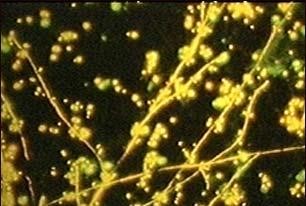Vaginal yeast infection
Contents
General Information
Vaginal yeast infection is an infection of the vagina, most commonly due to the fungus Candida albicans.
Causes
Most women have a vaginal yeast infection at some time. Candida albicans is a common type of fungus. It is often found in small amounts in the vagina, mouth, digestive tract, and on the skin. Usually it does not cause disease or symptoms.
Candida and the many other germs that normally live in the vagina keep each other in balance. However, sometimes the number of Candida albicans increases, leading to a yeast infection.
This can happen if you are:
- Taking antibiotics used to treat other types of infections. Antibiotics change the normal balance between germs in the vagina by decreasing the number of protective bacteria.
- Pregnant
- Obese
- Have diabetes
A yeast infection is not a sexually transmitted illness. However, some men will develop symptoms such as itching and a rash on the penis after having sexual contact with an infected partner.
Having many vaginal yeast infections may be a sign of other health problems. Other vaginal infections and discharges can be mistaken for a vaginal yeast infection.

This microscopic film shows a fluorescent stain of Candida. Candida is a yeast (fungus) that causes mild disease, but in immunocompromised individuals it may cause life-threatening illness.
Symptoms
- Abnormal vaginal discharge
- Ranges from a slightly watery, white discharge to a thick, white, chunky discharge (like cottage cheese)
- Pain with intercourse
- Painful urination
- Redness and swelling of the vulva
- Vaginal and labial itching, burning
Exams and Tests
A pelvic examination will be done. It may show swelling and redness of the skin of the vulva, in the vagina, and on the cervix. The health care provider may find dry, white spots on the vaginal wall. There may be cracks in the skin of the vulva.
A small amount of the vaginal discharge is examined using a microscope. This is called a wet mount and KOH test). Sometimes, a culture is taken when the infection does not improve with treatment or comes back many times. Your health care provider may order other tests to rule out other causes of your symptoms.
Treatment
Medications to treat vaginal yeast infections are available in either creams or suppositories. Most can be bought without a prescription.
Treating yourself at home is probably okay if:
- Your symptoms are mild and you do not have pelvic pain or a fever
- This is not your first yeast infection and you have not had many yeast infections in the past
- You are not pregnant
- You are not worried about other sexually transmitted diseases from recent sexual contact
Medications you can buy yourself to treat a vaginal yeast infection are:
- Miconazole
- Clotrimazole
- Tioconazole
- Butoconazole
Read the packages carefully and use them as directed. Do not stop using these medications early because your symptoms are better. You will need to take the medicine for 3 - 7-days, depending on which medicine you buy. If you do not get get repeated infections, a 1-day medicine might work for you. You doctor can also prescribe a medicine called fluconazole. This medicine is a pill that you only take once. If your symptoms are more severe or you have repeat vaginal yeast infections, you may need:
- Medicine for up to 14 days
- Clotrimazole vaginal suppository or fluconazole pill every week to prevent new infections
To help prevent and treat vaginal discharge:
- Keep your genital area clean and dry. Avoid soap and rinse with water only. Sitting in a warm, but not hot, bath may help your symptoms.
- Avoid douching. Although many women feel cleaner if they douche after menstruation or intercourse, it may actually worsen vaginal discharge because it removes healthy bacteria lining the vagina that protect against infection.
- Eat yogurt with live cultures or take Lactobacillus acidophilus tablets when you are on antibiotics to prevent a yeast infection.
- Use condoms to avoid catching or spreading sexually transmitted infection (STI).
- Avoid using feminine hygiene sprays, fragrances, or powders in the genital area.
- Avoid wearing extremely tight-fitting pants or shorts, which may cause irritation.
- Wear cotton underwear or cotton-crotch pantyhose. Avoid underwear made of silk or nylon, because these materials are not very absorbant and restrict air flow. This can increase sweating in the genital area, which can cause irritation.
- Use pads and not tampons.
- Keep your blood sugar levels under good control if you have diabetes.
Source: http://www.nlm.nih.gov/medlineplus/ency/article/001511.htm

